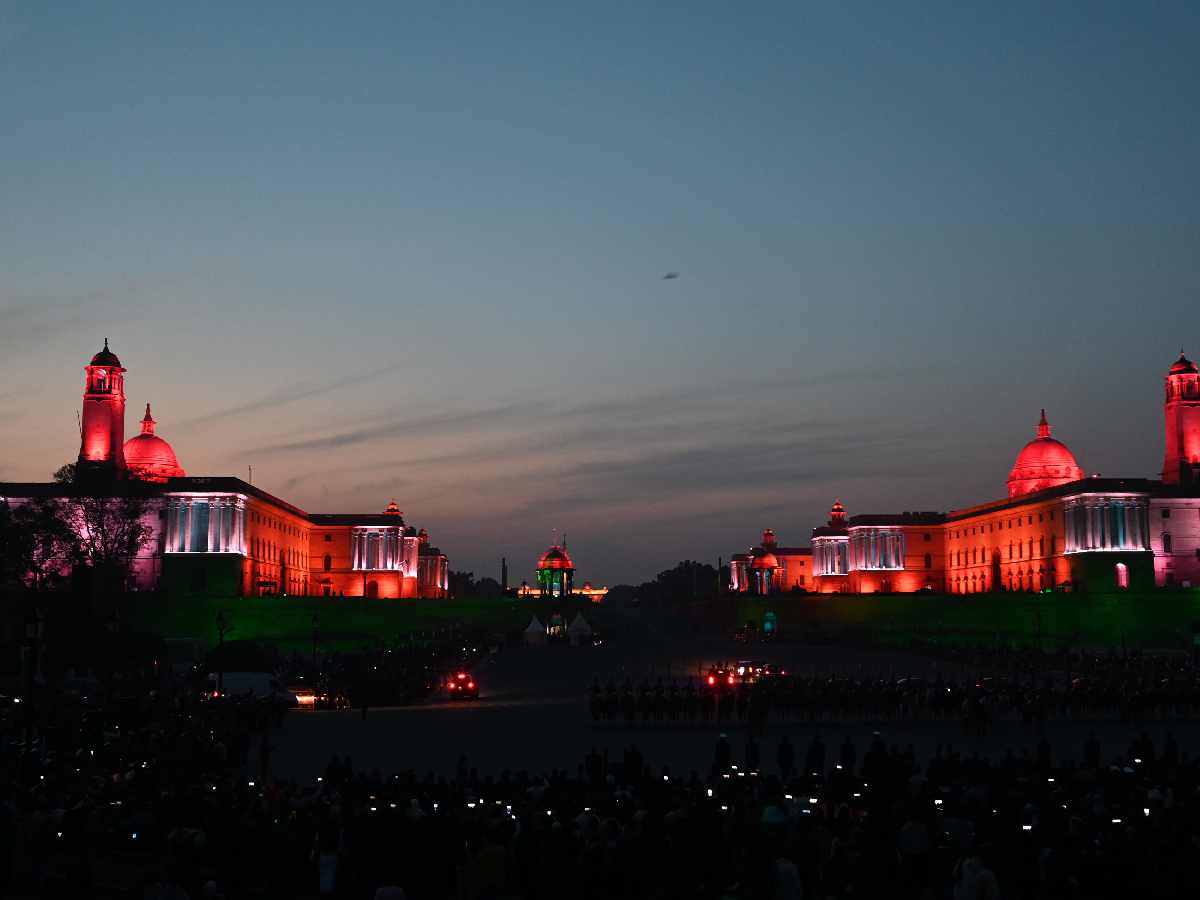
A view of the illuminated South Block, North Block . Photo: Getty Images
Delhi: For decades, Herbert Baker’s red sandstone North and South Blocks have stood as the power centres of India’s nation-state. The North Block currently houses the Home and Finance Ministries, while the South Block accommodates the offices of the Prime Minister, Defence Ministry, Ministry of External Affairs, and Cabinet Secretariat. These grand structures continue to symbolise India’s administrative might.
However, this era is nearing its end. Soon, the North and South Blocks will be transformed into the Yug Yugeen Museum as part of the Central Vista redevelopment project. The Ministry of Housing and Urban Affairs (MoHUA) has already commenced work on preserving the North Block, with plans to revamp the South Block next. Notably, the 2023–24 Union Budget, presented by Finance Minister Nirmala Sitharaman, marked the final one prepared in the iconic North Block, built-in 1929. In future, this hallmark of governance will no longer be the centre for crafting India’s economic roadmap.
North Block: The budget’s birthplace
The North Block’s connection to India’s Union Budget is deeply ingrained. It has long been the hub where Finance Ministers and their teams work tirelessly to finalise budget proposals. Sector representatives and experts visit the building to discuss their demands, influencing the budget’s structure. The speech, printed in the North Block’s basement press under strict confidentiality, is then presented in Parliament—an enduring tradition.
Beyond this administrative function, the North Block boasts stunning artworks depicting themes like justice, war, and peace. Similarly, the South Block features paintings showcasing various Indian cities and emblems of historical kingdoms, enriching these buildings with cultural depth.
Baker and Lutyens: Friends turned rivals
Herbert Baker’s contribution to New Delhi’s architectural landscape is significant, yet his achievements are often overshadowed by his association with Edwin Lutyens. Initially friends and collaborators, the two architects clashed over their differing visions during the design of New Delhi. In his obituary for Lutyens, Baker reflected on their personal and professional differences, acknowledging their shared success in creating a unified architectural vision for the city.
Indian elements in Baker’s design
Baker’s work integrates distinctively Indian elements like the jaali, chajja, and chattri, blending local aesthetics with colonial grandeur. The jaali, an intricately carved stone screen, provides ventilation and shields against harsh sunlight. The chajja, a projecting stone ledge, protects walls and windows from rain and sun. The chattri, an umbrella-shaped dome, adds elegance while breaking the monotony of flat skylines. Baker’s frequent visits to Rajasthan inspired his use of these features, creating a harmonious fusion of British and Indian architectural styles.
Also Read: The unsettling history of 33 Shamnath Marg: Once abode of Delhi’s Chief Ministers
As historian RV Smith noted, “Baker combines the best of English architecture with traditional Indian forms like the Mughal and Rajputana styles. The use of jaali, chajja, and chattri is tailor-made for India’s climate, while motifs like the lotus and elephants reflect a distinct Mughal influence.”
Timeless Architecture
Baker designed with longevity in mind, aiming for his buildings to endure 75–80 years—and they have surpassed this mark. The North and South Blocks remain strikingly contemporary, their long classical facades capped by 217-foot domes reminiscent of Baker’s earlier work in Pretoria, South Africa. With their Mughal-style gateways, sprawling corridors, and inner fountain courts, these structures exemplify timeless elegance. The North Block’s gateway bears an inscription:
“Liberty will not descend to a people: a people must raise themselves to liberty. It is a blessing which must be earned before it can be enjoyed.”
A new chapter
Although the North and South Blocks will no longer house India’s highest offices, their legacy will continue. The annual Beating Retreat Ceremony at Vijay Chowk will ensure these iconic buildings remain a vibrant part of the nation’s cultural memory.
Herbert Baker, the man behind these enduring landmarks, quietly passed away in Kent in 1946. His work, however, lives on as a testament to his architectural genius, blending history, culture, and functionality. The transition to museums signals the end of an era—but also the preservation of a legacy that will inspire generations to come.
Rival leagues trigger players’ suspensions and a legal battle in Indian golf, for now
Former Delhi CM Kejriwal criticises Centre, Delhi govt over worsening air pollution, alleges AQI manipulation
Delhi Police raids Nangloi unit producing fake engine oil, seizes over Rs 1 crore worth…
Mukesh Sharma reimagines digital components as living matter in his solo exhibition ‘Decoding Digital DNA’
Nine accused were arrested in coordinated raids as police uncovered organised networks supplying mule bank…
Nearly 1.57 lakh PUC challans issued in two months as Delhi steps up GRAP enforcement…